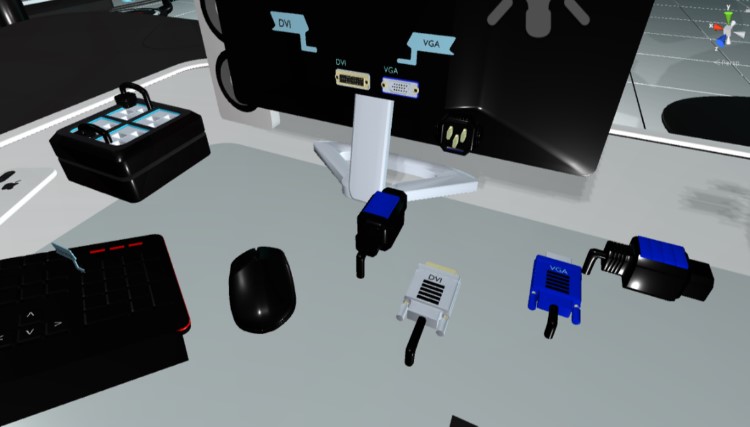การพัฒนาห้องปฏิบัติการเสมือนเพื่อเรียนรู้การประกอบคอมพิวเตอร์ด้วยเทคโนโลยีความเป็นจริงเสมือนโดยใช้อุปกรณ์โอคูลัส
Main Article Content
Abstract
Nadh Ditcharoen, Ruengyos Soikeaw, Acharaporn Khanthusaeng and Anusorn Bunteong
รับบทความ: 12 สิงหาคม 2562; แก้ไขบทความ: 16 พฤศจิกายน 2562; ยอมรับตีพิมพ์: 6 ธันวาคม 2562
บทคัดย่อ
งานวิจัยนี้มีวัตถุประสงค์เพื่อออกแบบและพัฒนาห้องปฏิบัติการเสมือนสามมิติสำหรับทดลองฝึกประกอบคอมพิวเตอร์ด้วยเทคโนโลยีความเป็นจริงเสมือนโดยใช้อุปกรณ์โอคูลัส ซึ่งพัฒนาเป็นสื่อเสริมประกอบการเรียนรู้รายวิชาคอมพิวเตอร์ที่มีปฏิสัมพันธ์กับผู้เรียน ในรูปแบบโมเดลแอนิเมชันสามมิติ แสดงผลในมุมมองสภาพแวดล้อม 360 องศา พร้อมทั้งเสียงประกอบ ทำให้ผู้เรียนได้สัมผัสประสบการณ์เสมือนได้เข้าไปอยู่สภาพแวดล้อมจริง ภายในห้องปฏิบัติการเสมือนนอกจากผู้เรียนจะได้เรียนรู้เกี่ยวกับเครื่องคอมพิวเตอร์ในยุคต่าง ๆ แล้วยังสามารถฝึกประกอบเครื่องคอมพิวเตอร์ผ่านภารกิจและแบบทดสอบ ที่มีเนื้อหาครอบคลุมเรื่องฮาร์ดแวร์และอุปกรณ์ต่อพ่วงทางคอมพิวเตอร์ เครื่องมือที่ใช้พัฒนา คือ โปรแกรมเบลนเดอร์ (Blender) และโปรแกรมยูนิตี้ (Unity 3D) ใช้งานบนระบบ ปฏิบัติการวินโดวส์แสดงผลผ่านแว่นโอคูลัสริฟท์ (Oculus Rift) และปฏิสัมพันธ์กับโมเดลด้วยอุปกรณ์โอคูลัสทัช (Oculus Touch) ห้องปฏิบัติการเสมือนที่พัฒนาขึ้นนี้เหมาะสำหรับนักเรียนระดับมัธยมศึกษา ซึ่งช่วยส่งเสริมการเรียนรู้ กระตุ้นความสนใจของผู้เรียน ส่งเสริมการเรียนรู้ในลักษณะการเรียนเชิงรุก (active learning) เสริมสร้างความคิดสร้างสรรค์ และใช้เป็นสื่อการเรียนการสอนของครูได้อีกด้วย การทดสอบระบบเบื้องต้นด้วยการทดลองใช้งานและศึกษาความคิดเห็นด้วยแบบสอบถามจากนักเรียนที่มาร่วมงานมหกรรมประกวดเทคโนโลยีสารสนเทศแห่งประเทศไทย ปี 2562 ที่กรุงเทพ มหานคร โดยการสุ่มตัวอย่างแบบบังเอิญ จำนวน 24 คน พบว่า ค่าเฉลี่ยของความคิดเห็นที่มีต่อห้อง ปฏิบัติการเสมือนสามมิตินี้มีค่าเท่ากับ 4.54 (ส่วนเบี่ยงเบนมาตรฐานเท่ากับ 0.65)
คำสำคัญ: เทคโนโลยีความเป็นจริงเสมือน ห้องปฏิบัติการเสมือน การประกอบคอมพิวเตอร์ โอคูลัส
Abstract
The objective of this research was to design and to develop a 3D virtual laboratory for practicing computer assembly computer virtual laboratory via oculus devices to which virtual reality technology was applied. It was designed and developed as an interactive media supplemented to computer course in form of 3D animation model displayed in 360–degree perspective with the sound effect so that learners are able to get an experience like being in a real environment. Inside the virtual laboratory, the learners are able not only to learn about computer ages but also to practice computer assembly through missions and exercises covering computer hardware and peripherals. The development tools consisted of Blender and Unity 3D. The virtual laboratory is run on Windows displayed via oculus rift and interacting with models using oculus touch. It is built suitable for high school students which helps engage learners’ interest, promote the active learning process, encourage learners’ creativity, and also use as a learning media for teachers. Users’ opinion toward the virtual laboratory was evaluated in our preliminary experiment by using a questionnaire collected, by accidental sampling, from 24 students who participated in the 2019 Thailand IT Contest Festival in Bangkok. The findings indicated that the average of students’ opinion was 4.54 (SD = 0.65).
Keywords: Virtual reality technology, Virtual laboratory, Computer assembly, Oculus
Downloads
Article Details

This work is licensed under a Creative Commons Attribution-NonCommercial 4.0 International License.
References
Atraksa, I. (2013). A Development of a virtual museum model on computer technology. Journal of Education Research, Faculty of Education, Srinakharinwirot University 8(2): 275–284. (in Thai)
Bonwell, C. C., and Eison, J. A. (1991). Active Learning: Creating Excitement in the Classroom. ASHE–ERIC Higher Education Report. Washington, DC: School of Education and Human Development, George Washington University.
Borjakpan, S., Treerat, T., and Karsabai, P. (2016). The development of an interactive edutainment virtual reality exploring the solar systems. 4th Rajabhat University National and International Research and Academic Conference (RUNIRAC IV) (pp.37–46). Buriram: Buriram Rajabhat University. (in Thai)
Borjakpan, S., Chueawangkham, E., Deeruksa, S., and Maliwong, W. (2019). Application for learning on human digestive system with virtual reality. Udon Thani Rajabhat University Journal of Sciences and Technology 6(1): 95–111.
Ditcharoen, N., Bunteong, A., and Srisuporn, N. (2016). Development of virtual class room for learning solar system using virtual reality technology. The 6th PSU Education Conference (pp. 16 – 24). Songkla: Prince of Songkla University. (in Thai)
Kaewsriprat, A. (2017). Development of 3D Virtual Reality Interactive Game on Mobile Devices for Upper Primary Students. Master’s Thesis. Bangkok. King Mongkut’s University of Technology North Bangkok. (in Thai)
Kapp, K. M. (2012). The Gamification of Learning and Instruction. San Francisco: Wiley.
Khampliew, A., Chalermsuk, C. and Chuem-sombat, K. (2018). Development of Thailand tourism application using virtual reality technology. UTCC Academic Day (pp.1873–1885). Bangkok: University of the Thai Chamber of Commerce. (in Thai)
Khamprao, W., and Panyanuparp, S. (2015). 3D Game for Learning Vocabulary via Virtual Reality on Android. B.Sc. Senior Project in Information Technology. Ubon Ratchathani: Ubon Ratchathani University. (in Thai)
Kokram, N. (2016). 3D Model of Virtual Tourism at Pha Taem National Park. B.Sc. Senior Project in Information Technology. Ubon Ratchathani: Ubon Ratchathani University. (in Thai)
Kullimratchai, P., and Aonbunua, T. (2015). Teaching media: Computer integration using interactive multimedia computer assisted instruction. EAU Heritage Journal 5(5): 91–98. (in Thai)
Lertbumrungchai, K. (2017). The meaning of Gamification. Retrieve from http://touch point.in.th/gamification/, October 12, 2019.
Meyers, C., and Jones, T. B. (1993). Promoting Active Learning: Strategies for the College Classroom. San Francisco: Jossey–Bass.
Saekhow, N., and Prasertruay, S. (2015). Development of virtual world model for interactive multimedia instruction on exploring the computer world. VRU Research and Development Journal Humanities and Social Science 10(1): 36–45. (in Thai)
Santiworarak, L., and Poonsawas, B. (2015). Developing prototype of virtual reality application to simulation and control walking player for people disability. The 7th National Conference on Information Technology (pp.129–134). Chiangmai: Le Meri-dien Chiangmai. (in Thai)
Sapawut, S. (2017). Games for Learning of Earth and Stars in Virtual Astronomy Classroom via Oculus Devices. B.Sc. Senior Project in Information Technology. Ubon Ratchathani: Ubon Ratchathani University. (in Thai)
SiamVR. (2016). Detail of Oculus Rift Virtual Reality. Retrieved from http://www. siamvr.com/oculus-rift/oculus-rift-virtual-reality/, December 7, 2018.
Sinahawatana, T. (2016). 3D Virtual Museum of Lent Candle via Oculus Rift on Android. B.Sc. Senior Project in Information Technology. Ubon Ratchathani: Ubon Ratcha-thani University. (in Thai)
Suwannaphoom, K. (2014). Active learning. Retrieved from http://teachingresources.psu.ac.th/files/meded_focus/2557/06june_2014.pdf, October 12, 2019.
Thongsiri, W., and Boonsuya, A. (2015). Vir-tual Exhibition by Google Card Board using Simulating a Virtual Exhibition Room. B.Sc. Senior Project in Information Technology. Ubon Ratchathani: Ubon Ratchathani University. (in Thai)
Waiwanichkit, P. (2018). The study of vrtual reality and augmented reality technology – Impact with 5G mobile network. NBTC Annual Review 2018: 153–171. (in Thai)
Yuangthong, S. (2014). Fundamentals of Computer and Information Technology. Bangkok: SE-ED.
